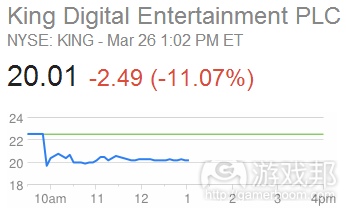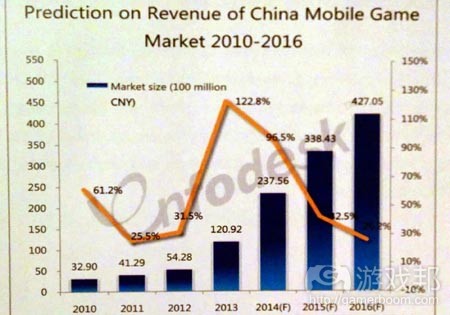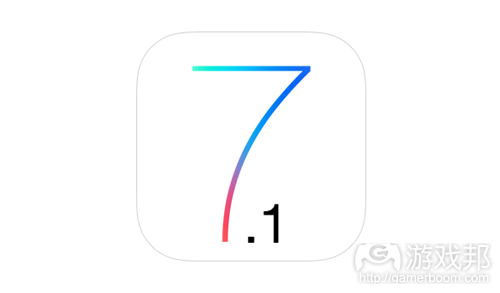每日观察:关注King IPO表现低于预期等消息(3.27)
1)据Venturebeat报道,King本周三在美国纽约证券交易所上市,开盘每股售价为20.5美元,之后数小时跌至每股19.9美元,降幅超过11%。
该公司目前市值为60亿美元,其首席执行官Riccardo Zacconi目前在公司掌握的股份价值约6亿美元。这家总部位于伦敦的公司在IPO中筹资3.26亿美元,成为手机游戏行业身价最高的公司之一。
尽管投资者担忧King只是昙花一现的公司,并可能因此而回想起Zynga在2011年表现惨淡的IPO。不过King目前仍有9700万玩家,2013年收益达18.9亿美元,利润为5.68亿美元,因为仍然具备足够创造或收购下一款热作的资本。
2)市场调研公司IDC和AppAnnie最近报告显示,手机应用内置广告收益一年增幅达60%左右,预计在2017年将超过PC网络展示广告收益。
2013年手机应用商店(iOS和Google Play)收益增长2.3倍左右,而手机应用内置广告增长60%,超过了手机网页广告(50%)以及PC网页广告(10%)。约有40%开发者在自己的应用中使用内置广告。
手机应用,尤其是手机游戏主要通过免费模式和应用内置广告创收。美国是手机应用相关收益的最大市场,预计2013年至2017年美国应用收益将增长3.5倍。
预计印度到2017年的手机应用收益将增长8.7倍;主流市场的智能手机普及率到2017年将增长2.3倍。
基于免费模式的应用内置交易目前占比92%,付费应用占比4%,免费与付费相结合的应用占比4%。在2013年免费模式应用收益增长211%,而应用内置广告增长56%左右。付费应用收益下降29%,免费付费结合的应用收益下降23%。
付费应用已经不再是市场主力,其普遍售价为2至6美元。
多数开发者表示,在一个月内有2%至5%用户会购买虚拟内容。
3)据GMGC最近发布报告显示,2013年中国手机游戏市场规模为22亿美元(138亿元人民币),比2012年增长156%。但这一市场发展正在减缓,在2013年第四季度,其增幅已经降至27%(而第三季度则是37%)。
但与发达国家相比,这一增长率仍然强劲。预计到2014年中国手机游戏市场将增长97%,达到38亿美元(238亿元人民币);到2016年这一市场规模将达69亿美元(427亿元人民币)。
但中国手机游戏公司并不局限于本土市场,2013年中国手机游戏公司的“海外市场”(主要是东南亚)规模达1.6亿美元(10亿元人民币),增幅为150%。
4)据TouchArcade报道,Supercell日前宣布旗下新游戏《Boom Beach》将在本周四面向全球iOS用户独家发布(游戏邦注:但并未确认是iOS限时独家还是永久独家发布)。
观察者在去年11月的预览中发现,这款游戏与《Clash of Clans》相比更像是现代游戏战争,并且提供了全新的游戏体验,而不仅仅是在后者的基础上改头换面。
5)据venturebeat报道,苹果日前通过其开发者网站宣布,已有85%的苹果移动设备运行最新版本的操作系统iOS 7,iOS 7.1发布仅三天普及率就达到21%。
相比之下,谷歌Android系统最新的版本自2013年10月发布已来也仅覆盖2.5%的Android设备。据谷歌开发者网站所示,目前使用最普遍的Android操作系统是2012年7月发布的Jely Bean,其覆盖率为35.3%。(本文为游戏邦/gamerboom.com编译,拒绝任何不保留版权的转载,如需转载请联系:游戏邦)
1)King CEO shakes off sour Candy Crush Saga investors
Dean Takahashi
King Digital Entertainment hasn’t had a stellar initial public offering, starting out its first trading at $22.50 a share and then dropping within a few hours to $19.90 a share, down more than 11 percent.
But Riccardo Zacconi, the chief executive of King, isn’t crushed. The maker of the monster mobile social gaming hit Candy Crush Saga is now valued at $6 billion on the New York Stock Exchange, and Zacconi’s own stake in the company is worth around $600 million. The company, which is incorporated in Ireland and has its headquarters in London, raised $326 million for itself in the offering, and it’s one of the biggest players in the multibillion dollar mobile gaming industry.
Analysts and investors have been worried about whether King is a one-hit wonder, and the publisher has argued in its own filing that it has a methodical approach to game development and access to more than 180 game intellectual properties. Still, investors are a bit spooked and may be recalling memories of Zynga’s weak IPO back in 2011.
But Zacconi has been at this for more than a decade, and Candy Crush Saga still has more than 97 million players. It reported $568 million in profits on $1.89 billion in revenues in 2013.
That gives Zacconi plenty of resources to build or buy the next big hit.(source:venturebeat)
2)Mobile in-app ad revenues will surpass PC online display advertising by 2017
Dean Takahashi
Mobile in-app ads are growing at about 60 percent a year and are expected to surpass PC online display ad revenue by 2017, according to a report by market researchers IDC and AppAnnie.
Mobile app stores (iOS and Google Play) grew revenue by 2.3 times in 2013, while mobile in-app ads grew at 60 percent, outpacing the 50 percent growth for mobile browser ads and the 10 percent growth for PC browser-based ads. About 40 percent of developers use in-app ads in their apps.
Mobile apps, especially games, are monetizing well through free-to-play (a kind of freemium model) and in-app ads. Most of the key markets in the world are expected to move quickly toward in-app advertising models.
The U.S. is expected to be the top source of mobile app-related revenue. App revenues are expected to growth 3.5 times in the U.S. from 2013 to 2017.
India, meanwhile, is expected to see its mobile app-related revenue grow 8.7 times by 2017. That will happen as the result of rapid smartphone adoption. In key countries, smartphone adoption is expected to grow another 2.3 times by 2017.
IDC and AppAnnie advise publishers to consider different business models, depending on the region. India skews toward in-app advertising, while Japan and Russia skew toward app store revenue. Ad networks offer a simple way for publishers to fill ad inventory without the resources needed for mediation platforms or real-time bidding exchanges.
In-app purchases based on a free-to-play model now account for 92 percent of purchases, while 4 percent come from paid apps and 4 percent from a blend of free and paid. In 2013, freemium apps grew 211 percent in revenue, while in-app ads grew 56 percent. Paid app revenues declined 29 percent and free-paid combos (“paidmium”) declined 23 percent.
Paid apps aren’t a big part of the market anymore, but the typical prices for those are $2 to $6.
In a given month, most developers say that 2 percent to 5 percent of users will make a virtual goods purchase.
For companies that switch business models, the results can be positive. Electronic Arts switched from a paid model to free-to-play when it launched Real Racing 3, a mobile racing game. The popularity of the app and its revenues skyrocketed.(source:venturebeat)
3)Boom times: Chinese mobile games market grew 156% in 2013 to $2.2 billion
by Jon Jordan
With the Global Mobile Game Conference 2014 kicking off in a smoggy Beijing, it’s time to check out new predictions for the size of the world’s fastest growing mobile games market.
According to a report released by the GMGC and produced using information from various Chinese market intelligence companies – Umeng, TalkingData, App Annie and Analysys – the Chinese mobile game market in 2013 was worth $2.2 billion (RMB 13.8 billion).
That’s up 156 percent compared to 2012.
However, growth is slowing. On a quarterly basis, in Q4 2013, it was down to 27 percent compared to growth of 37 percent in Q3.
Big times coming
Of course, that slowdown is only relative; grow rate remain very strong compared to the developed world.
Looking ahead to 2014, it’s expected that the size of the Chinese mobile games market will grow 97 percent to $3.8 billion (RMB 23.8 billion).
Again, annual growth – while remaining high – is dropping – see the yellow line.
It will only be mid-double digits from 2015, but that should still see the total market being worth around $6.9 billion (RMB 42.7 billion) by 2016.
But Chinese companies aren’t only looking for Chinese players. There’s a small if fast growing international sector for Chinese developed games, especially in southeast Asia.
It’s estimated that this ‘international market’ is currently worth around $160 million (around RMB 1 billion) to Chinese mobile companies, with growth in 2013 of 150 percent.(source:pocketgamer)
4)Boom Beach, the next game from Supercell, launches this Thursday
By Jim Squires
First spotted by TouchArcade earlier today, it looks as though Supercell’s Boom Beach will finally be leaving its Canadian soft launch shores and heading to you this Thursday.
The announcement was made via tweet from the official App Store account, confirming that the Clash of Clans follow up was not only coming, but will be an App Store exclusive. (Whether that’s a real exclusive or timed exclusive is anybody’s guess).
We first took a look at this one back in November with a hands-on preview, and were pretty impressed with what we saw. Beyond the cosmetic change (Boom Beach is to modern warfare as Clash of Clans is to medieval fantasy), there were some real twists that should give Clash of Clans veterans a brand new challenge rather than a fresh coat of paint.
We’ll be diving back in for a full review and guide soon. Be sure to keep an eye out for both just as soon as Boom Beach hits the App Store! (source:gamezebo)
5)Apple’s upgrade rates destroy Android: iOS 7 now runs on 85% of iDevices
Harrison Weber
A whopping 85 percent of all Apple’s mobile devices run the latest version of its operating system, iOS 7, the company announced today on its developer site.
Apple commonly sees quick operating system adoption following major updates, a trend encouraged by the fact that Apple builds its own hardware and operates a closed software ecosystem.
Google’s more open Android OS sees comparatively dismal upgrade ratesndespite its widespread use. Kitkat, Google’s latest major Android update, runs on just 2.5 percent of Android devices in spite of its October 2013 release date.
The most commonly used Android OS, according to Google’s developer site, is the first release of Jelly Bean (from back in July 2012) at an adoption rate of 35.3 percent.
Apple’s latest minor update, iOS 7.1, reached 21 percent adoption rates in just three days.
At its core, Apple runs a very different business from Google’s. Google’s market share of Android is significantly higher than iOS due to the adoption of Android by third-party device manufacturers. In other words, you can buy an iPhone from Apple, but you can by an Android from just about any company.
Clearly, Google’s model helped make Android an industry standard. As a result, however, slow upgrade rates continuously create a difficult situation for developers looking to build the latest and greatest apps. Similarly, it takes quite a while for cutting edge Android updates to reach the masses.(source:venturebeat)












































 闽公网安备35020302001549号
闽公网安备35020302001549号